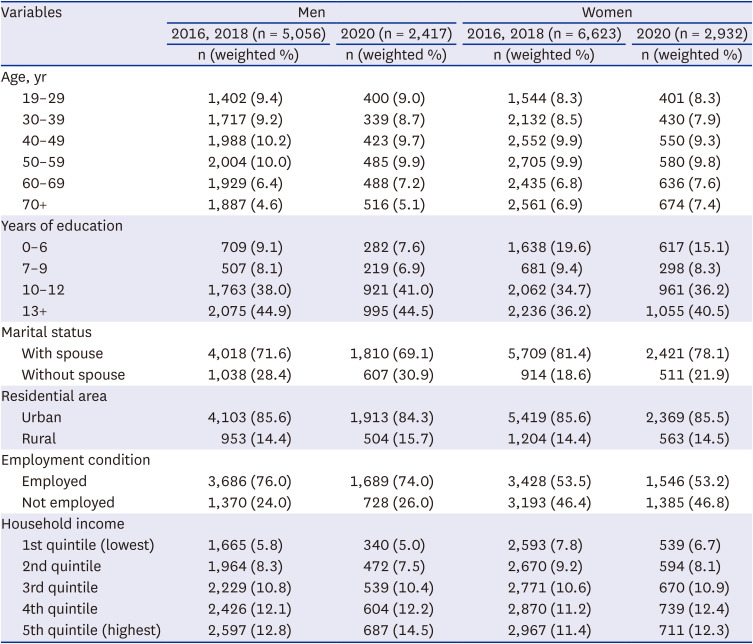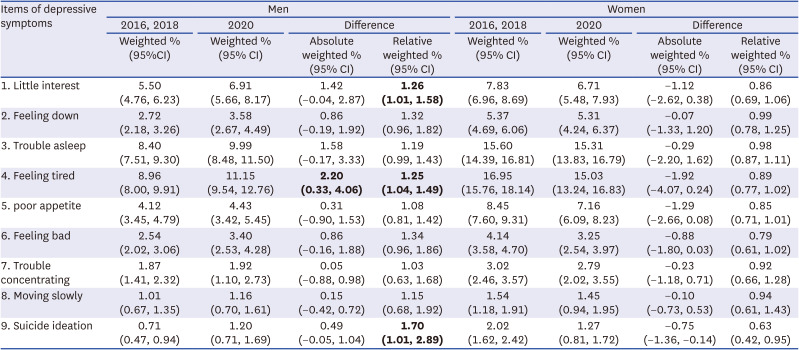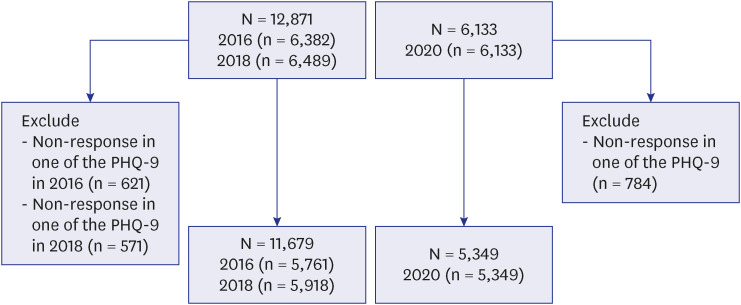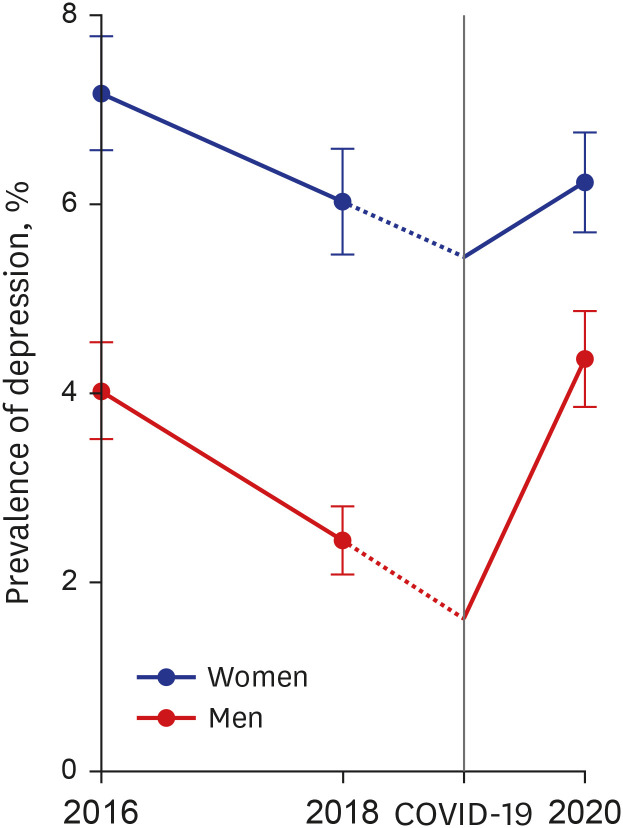1. Bueno-Notivol J, Gracia-García P, Olaya B, Lasheras I, López-Antón R, Santabárbara J. Prevalence of depression during the COVID-19 outbreak: a meta-analysis of community-based studies. Int J Clin Health Psychol. 2021; 21(1):100196. PMID:
32904715.

2. Cramer AO, Borsboom D, Aggen SH, Kendler KS. The pathoplasticity of dysphoric episodes: differential impact of stressful life events on the pattern of depressive symptom inter-correlations. Psychol Med. 2012; 42(5):957–965. PMID:
22093641.

3. Weissman MM, Klerman GL. Sex differences and the epidemiology of depression. Arch Gen Psychiatry. 1977; 34(1):98–111. PMID:
319772.

4. Kim TJ, von dem Knesebeck O. Perceived job insecurity, unemployment and depressive symptoms: a systematic review and meta-analysis of prospective observational studies. Int Arch Occup Environ Health. 2016; 89(4):561–573. PMID:
26715495.

5. Boettcher N, Mitchell J, Lashewicz B, Jones E, Wang J, Gundu S, et al. Men’s work-related stress and mental health: illustrating the workings of masculine role norms. Am J Men Health. 2019; 13(2):1557988319838416.

6. Hadar-Shoval D, Alon-Tirosh M, Asraf K, Tannous-Haddad L, Tzischinsky O. The association between men’s mental health during COVID-19 and deterioration in economic status. Am J Men Health. 2022; 16(2):15579883221082427.

7. Oh K, Kim Y, Kweon S, Kim S, Yun S, Park S, et al. Korea National Health and Nutrition Examination Survey, 20th anniversary: accomplishments and future directions. Epidemiol Health. 2021; 43:e2021025. PMID:
33872484.

8. Kroenke K, Spitzer RL, Williams JB, Löwe B. The Patient Health Questionnaire Somatic, Anxiety, and Depressive Symptom Scales: a systematic review. Gen Hosp Psychiatry. 2010; 32(4):345–359. PMID:
20633738.

9. Han C, Jo SA, Kwak JH, Pae CU, Steffens D, Jo I, et al. Validation of the Patient Health Questionnaire-9 Korean version in the elderly population: the Ansan Geriatric study. Compr Psychiatry. 2008; 49(2):218–223. PMID:
18243897.

10. Ahn JY, Seo ER, Lim KH, Shin JH, Kim JB. Standardization of the Korean version of screening tool for depression (Patient Health Questionnaire-9, PHQ-9. J Korean Soc Biol Ther Psychiatry. 2013; 19:47–56.
11. Dimick JB, Ryan AM. Methods for evaluating changes in health care policy: the difference-in-differences approach. JAMA. 2014; 312(22):2401–2402. PMID:
25490331.

12. Vilovna AL, Sergeevna SE. Coronavirus impact on the global economy. Sci Rev Theory Pract. 2020; 10(10):2491–2498.

13. International Labour Organization (ILO). ILO Monitor: COVID-19 and the World of Work. Seventh Edition Updated Estimates and Analysis. Geneva, Switzerland: International Labour Organization;2021.
14. Lee J, Yang HS. Pandemic and employment: evidence from COVID-19 in South Korea. J Asian Econ. 2022; 78:101432. PMID:
34931110.

15. Ahmed MZ, Ahmed O, Aibao Z, Hanbin S, Siyu L, Ahmad A. Epidemic of COVID-19 in China and associated psychological problems. Asian J Psychiatr. 2020; 51:102092. PMID:
32315963.

16. Gualano MR, Lo Moro G, Voglino G, Bert F, Siliquini R. Effects of Covid-19 lockdown on mental health and sleep disturbances in Italy. Int J Environ Res Public Health. 2020; 17(13):4779. PMID:
32630821.

17. Xiong J, Lipsitz O, Nasri F, Lui LM, Gill H, Phan L, et al. Impact of COVID-19 pandemic on mental health in the general population: a systematic review. J Affect Disord. 2020; 277:55–64. PMID:
32799105.

18. Kim YS. KLSI Issue Paper No. 129 (2020-10). The Coronavirus Crisis and the Employment Trend in April 2020. Seoul, Korea: Korea Labor & Society Institute;2020.
19. Song SH. Coupang now among 3 biggest employers in Korea. The Korea Herald;2020. 11. 17.
20. Wahlbeck K, McDaid D. Actions to alleviate the mental health impact of the economic crisis. World Psychiatry. 2012; 11(3):139–145. PMID:
23024664.

21. Gili M, López-Navarro E, Castro A, Homar C, Navarro C, García-Toro M, et al. Gender differences in mental health during the economic crisis. Psicothema. 2016; 28(4):407–413. PMID:
27776609.
22. Ando S, Nishida A, Usami S, Koike S, Yamasaki S, Kanata S, et al. Help-seeking intention for depression in early adolescents: associated factors and sex differences. J Affect Disord. 2018; 238:359–365. PMID:
29908475.

23. Parker G, Brotchie H. Gender differences in depression. Int Rev Psychiatry. 2010; 22(5):429–436. PMID:
21047157.

24. Chang Q, Yip PS, Chen YY. Gender inequality and suicide gender ratios in the world. J Affect Disord. 2019; 243:297–304. PMID:
30261445.

25. de Menezes Galvão AC, Almeida RN, de Sousa GM Jr, Leocadio-Miguel MA, Palhano-Fontes F, de Araujo DB, et al. Pathophysiology of major depression by clinical stages. Front Psychol. 2021; 12:641779. PMID:
34421705.

26. Lighthall NR, Mather M, Gorlick MA. Acute stress increases sex differences in risk seeking in the balloon analogue risk task. PLoS One. 2009; 4(7):e6002. PMID:
19568417.

27. Kluen LM, Agorastos A, Wiedemann K, Schwabe L. Cortisol boosts risky decision-making behavior in men but not in women. Psychoneuroendocrinology. 2017; 84:181–189. PMID:
28750292.

28. Youssef FF, Bachew R, Bissessar S, Crockett MJ, Faber NS. Sex differences in the effects of acute stress on behavior in the ultimatum game. Psychoneuroendocrinology. 2018; 96:126–131. PMID:
29940425.

29. Nikolova YS, Bogdan R, Brigidi BD, Hariri AR. Ventral striatum reactivity to reward and recent life stress interact to predict positive affect. Biol Psychiatry. 2012; 72(2):157–163. PMID:
22534456.

30. Luking KR, Nelson BD, Infantolino ZP, Sauder CL, Hajcak G. Ventral striatal function interacts with positive and negative life events to predict concurrent youth depressive symptoms. Biol Psychiatry Cogn Neurosci Neuroimaging. 2018; 3(11):937–946. PMID:
30409389.

31. Cunningham S, Mazurka R, Wynne-Edwards KE, Milev RV, Pizzagalli DA, Kennedy S, et al. Cortisol reactivity to stress predicts behavioral responsivity to reward moderation by sex, depression, and anhedonia. J Affect Disord. 2021; 293:1–8. PMID:
34153656.

32. Shi P, Yang A, Zhao Q, Chen Z, Ren X, Dai Q. A Hypothesis of gender differences in self-reporting symptom of depression: implications to solve under-diagnosis and under-treatment of depression in males. Front Psychiatry. 2021; 12:589687. PMID:
34759845.

33. Welton RS. The management of suicidality: assessment and intervention. Psychiatry (Edgmont Pa). 2007; 4(5):24–34.
34. Kim AM. The short-term impact of the COVID-19 outbreak on suicides in Korea. Psychiatry Res. 2021; 295:113632. PMID:
33338860.

35. Ko M, Cho HM, Park J, Chi S, Han C, Yi HS, et al. Impact of the coronavirus disease pandemic on mental health among local residents in Korea: a cross sectional study. J Korean Med Sci. 2021; 36(46):e322. PMID:
34845878.

36. Lee H, Noh Y, Seo JY, Park SH, Kim MH, Won S. Impact of the COVID-19 pandemic on the mental health of adolescent students in Daegu, Korea. J Korean Med Sci. 2021; 36(46):e321. PMID:
34845877.

37. Lee KS, Sung HK, Lee SH, Hyun J, Kim H, Lee JS, et al. Factors related to anxiety and depression among adolescents during COVID-19: a web-based cross-sectional Survey. J Korean Med Sci. 2022; 37(25):e199. PMID:
35762142.









 PDF
PDF Citation
Citation Print
Print






 XML Download
XML Download